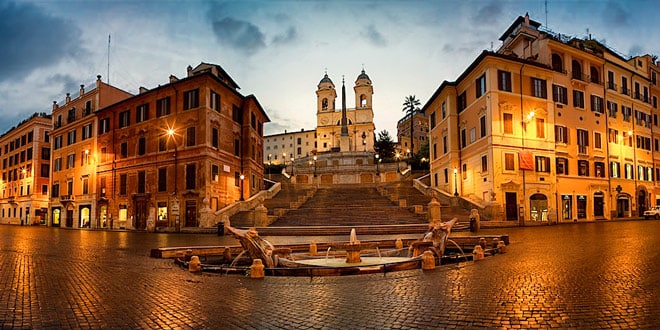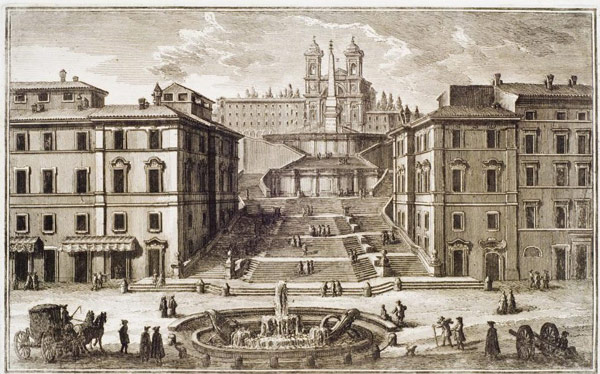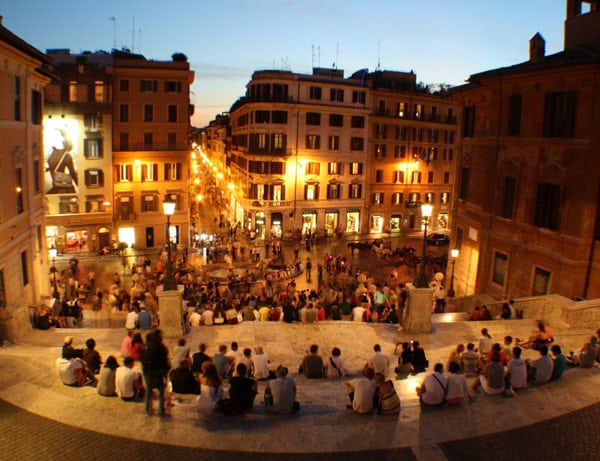The Spanish Steps are an unusual architectural curiosity, one of those places recommended to visit in Rome. A cascade of polished stone steps majestically descends from the top of Pincio Hill directly to the foot of the Piazza di Spagna.
This sightseeing is one of the inimitable visiting cards of Rome. The wide baroque steps attract visitors to the Italian capital and serve as a source of inspiration for filmmakers and artists.
Famous fashion houses: Prada, Dolce & Gabbana, Bulgari, and Dior chose to locate their stores a stone’s throw from such a magnificent place.
Page Contents
History
Admiring the glitter of the steps made of smooth travertine steps, travelers are sure to be interested in the history of the Spanish Steps.
The most curious fact from the biography of the attraction is its real name: “Staircase to the Temple of Trinità dei Monti” (Italian Scalinata di Trinità dei Monti).
The mysterious “Spanish woman” has a very ambiguous history, built on the confrontation between Spanish and French ambitions in Italy.
The titular church Trinita dei Monti, towering on the Pincio hill, was built in the 16th century by King Louis XII. The temple became the stronghold of the French monarchy in Rome. Consequently, it was of great importance to French citizens living far from their homeland. At the same time, the Spanish Square, located at the foot of Pincho Hill, was of no less importance to the Spaniards since it was the seat of the Spanish Embassy.
Louis XIV related to the Spanish monarchs, by his marriage with of the king’s daughter, Maria Theresa of Austria. Despite this, there were rather tense relations between the states. To rectify the situation, the French politician Etienne Geffier decided to connect the Trinita dei Monti temple and the Spanish Square with a staircase. For the implementation of such a symbolic idea in Rome, Geffier allocated funding in the amount of 20 thousand Italian scudos.
Construction
According to the original plan, the Spanish Steps were supposed to turn into a grandiose and incredibly pretentious architectural ensemble. The most controversial moment of the French idea is the equestrian statue of Louis XIV, crowning the building. The Roman authorities considered themselves offended and vetoed the building. Only in 1717, a competition among architects was held. It was won by the creative tandem of Alessandro Specchi and Francesco de Sanctis. The implementation of the architectural project began in 1723, spending considerable time planning the project, strengthening the square, and carrying out other preparatory work.
For two years, workers and builders were working hard building 138 steps carved from travertine.
As a result, the Spanish Steps received a broad central segment, framed by two narrower ones. Closer to the top of the hill, there is a viewpoint, which the side stairwells can reach. On the sides, the steps were delimited by stone rims in the Italian Baroque style (Barocco). For decoration, the architects used the heraldic symbols of the French Bourbon dynasty and the image of an eagle and a crown – attributes of papal power in Rome.
Modern look
There were no severe reconstructions from 1725 until the ’90s of the XX century. However, the steps started to ruin themselves during the time. The city authorities have found funds to restore the monument of history and architecture. In 1997, the refreshed attraction returned to the map of tourist routes. And again, travelers from all over the world rushed to see the most beautiful staircase of Europe.
Every spring, flowerpots with blooming azaleas and petunias paint the staircase in bright colors. In winter, the broad steps turn into a stage for Christmas scenes. The Church of Trinita dei Monti is a beautiful decoration for the view of the Spanish Steps.
However, its interior decoration is also of considerable interest. The most famous exhibit of the temple is the “Descent from the Cross” sculptural group made by Michelangelo’s student Daniele da Volterra.
A walk up the stairs opens a beautiful view of Spanish Square and the adjacent streets. The building at the foot of the stairs on the right is a home museum dedicated to the work of the English romantic poets John Keats and Mary Shelley. They say young Keats enthusiastically read his works to the already accomplished woman and poet Shelley, walking along the stone steps.
Besides, the Spanish Steps allow you to enjoy the beauty of the Barcaccia fountain, which adorns the Spanish Square. The fountain was built by the famous Italian sculptor Pietro Bernini (father of Giovanni Lorenzo Bernini) at the beginning of the 17th century. There is a legend that the once flooded waters of the Tiber threw the remains of a fishing boat onto the Italian coast. It was this plot that the master embodied in stone.
The Spanish Steps in Rome has its own filmography. In the 1953 melodrama “Roman Holiday”, the sophisticated Audrey Hepburn was eating ice cream sitting on the famous steps.
Many Italian movies are not complete without views of the capital, including shots made from Pincho Hill. Fashion shows by maestro Valentino, fashion parties from Dolce & Gabbana, and other entertainment events from the world of haute couture were held there.
How to get there
Address: 00187, Italy, Rome, Stairs to Trinità dei Monti (Italian 00187, Italy, Rome, Scalinata di Trinità dei Monti)
 Italy for me From Italy with love
Italy for me From Italy with love






